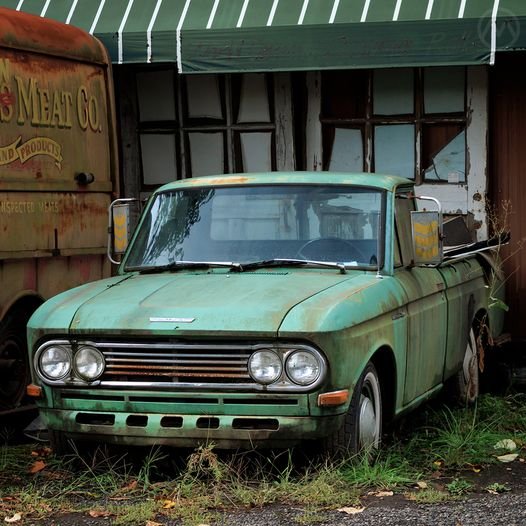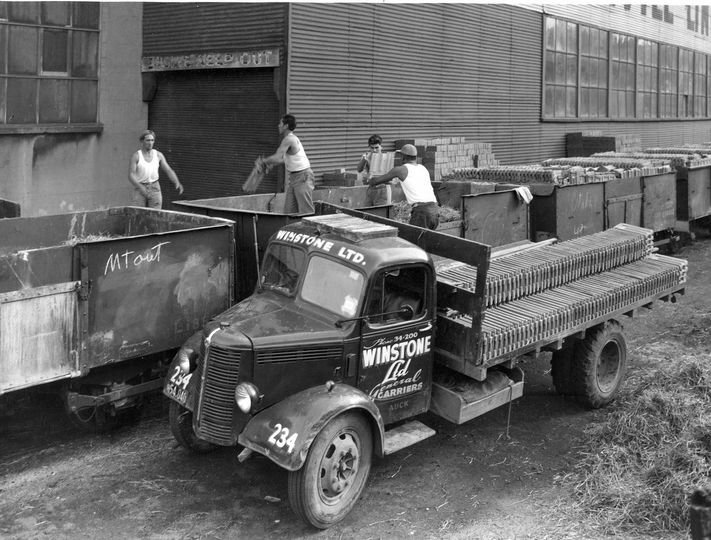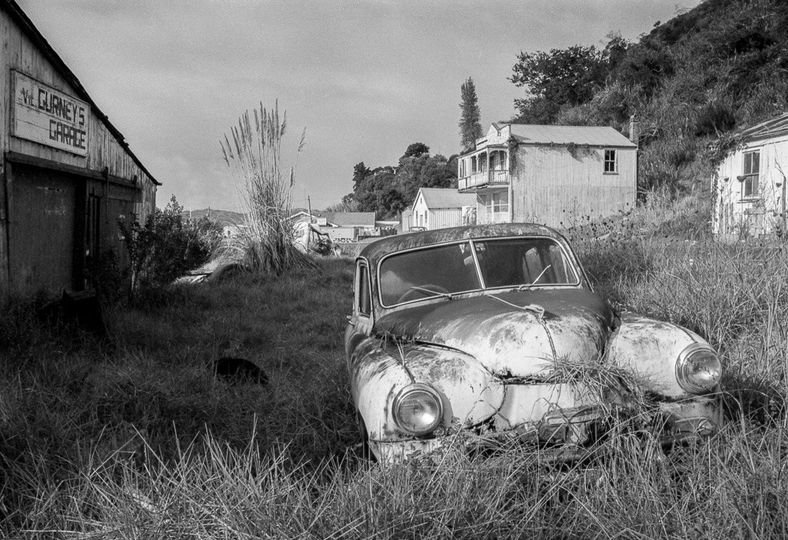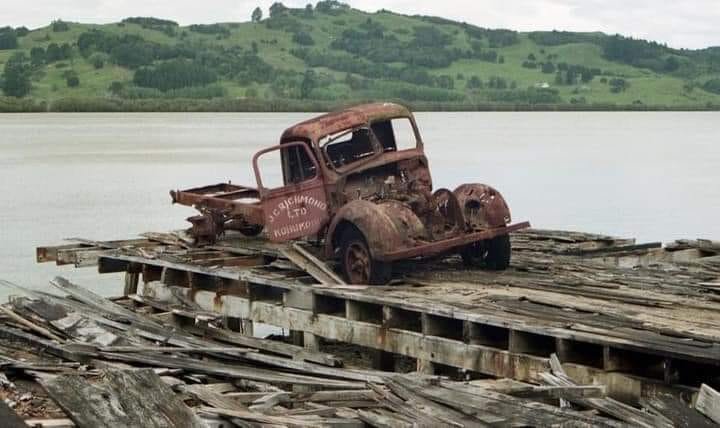

igor
-
Posts
19412 -
Joined
-
Last visited
-
Days Won
9
Posts posted by igor
-
-
One in @bananahamuck country from the book of faces with the usual longwinded story often found therein.
“Pininfarina” and “Pickup truck” are terms that don’t usually go together, but in this case there’s a direct connection. The Datsun 520 was a very close relative of the circa-1963 410 Bluebird, which was styled by the Italian house. Launched about 18 months after the Bluebird, the lines were adapted for the truck by Nissan’s in-house designers, and they would (arguably) age even better on the 520 than they did on the car that spawned it.The origins of the 410 and the 520 go back to Nissan’s tie-up with Austin. In 1952, the Japanese company had signed a licensing and technology-sharing agreement with the British, and it built Austin A40s and A50s under license for most of the 1950s.This led to a very strong Austin influence on the Japanese-designed products that gradually replaced the British cars, and a lasting technical influence. The J-Series four-cylinder engine in the green pickup you see here is based on the Austin/BMC B-Series engine.But by the early 1960s Nissan/Datsun had rebuilt itself from the postwar years, and it was keen to shake off the visual relationship with Austins, and that’s why Pininfarina was hired.While Pininfarina’s efforts yielded the cool-looking 410/411, Japanese firms never wanted to be too closely associated with having outsiders create their cars. The design has never been credited to any specific Pininfarina staffer and gets only a passing mention in the company’s own accounts of its history. After the 410 was finished, the Italians also helped shape the 1965 Nissan Cedric, but most future efforts were done in-house thereafter.Although Datsun had been building small trucks since 1934, the modern versions of its trucks really started in 1955 with the 120, which was based on the 110-series Bluebird sedan. The slightly larger 220 appeared in 1957, and finally, the even larger 320, based on the 310 Bluebird, arrived in the summer of 1961. The Bluebird’s evolution took a sharp turn with the Pininfarina connection, and it was launched in late 1963 to be ready for the 1964 Tokyo Olympiad.When the 410 appeared, it was only natural that the practice should continue, and so it was that in 1965 the 410 design was adapted into the 520 truck family. (420 was supposedly skipped because in Japanese it sounded too much like the word for “rudeness.”)As in the earlier generations of Datsun trucks, there were several body styles. The regular, separate-bed pickup would be the most famous, but there was also a fully-enclosed, wagon-like Van and a four-seat, “double cab” coupe utility. The two-door coupe utility, a feature of the 320-series (one of which we showed last year) was deleted. The lines worked well on the truck, and there are many nice details to be seen, like the flush door handles for improved aerodynamics.While the 220-Series was the first Datsun truck to be imported to the U.S., and the 320 the first to get real attention from American consumers, the 520 would be the truck that put Datsun on the map nationally. Its first model year was 1966, the same year Datsun signed up its 500th U.S. dealer, and it was a big seller right from the start.There had already been small European and British trucks like the Morris Minor and VW Type 2 on offer here, and the Volkswagen had enjoyed a fair degree of success, but none had the popularity of the Datsun, and the Japanese also got some help from the Johnson Administration’s “Chicken Tax” blunder. Although it raised the price of the little Datsun, it made all the European trucks totally uncompetitive on price, and while they withered Datsun and Toyota swooped in - but mostly Datsun.The Japanese automakers were able to produce the vehicles for less, and they partly circumvented the tariff through creative assembly practices, but the 520 was far more popular than Toyota’s first offering, the Stout.At first, 520s had two 7-inch front headlights, which gave them a faintly Alfa Romeo Giulia-like look, but 1967 brought a slight reshaping of the hood and quad-round units, as on the 410. Early ones used the 1.3-liter J13 engine, but later used the 1.5-liter J15, both mated to a four-speeder. An independent front suspension made them decent handlers, too. The mechanical pieces were absolutely indestructible, and although it wasn’t fancy, the 520 was very well made.It was handy too, with a much larger cabin than the 320-series, although it would still feel very small compared to any modern pickup. And there were cargo tie-downs and handy storage areas.While the 410 eventually seemed to be eclipsed in Japan by the popularity of the Toyota Corona, the 520 dominated the Stout. It wasn’t until Toyota absorbed Hino and started marketing that company’s Briska pickup as the Toyota Hilux that it began to catch up. The flagging appetite for the 410/411, however, sent Datsun’s designers to the drawing board for what became the famous 510.The ultimate 520, really a version of the facelifted 521, was the 1.6-liter L16 version, which used the 90-ish-hp SOHC engine from that car, but that came a little later.The 520’s biggest impact came here in the U.S. While all of Japan’s automakers built trucks like this in the 1960s (including some you rarely hear about, like the Briska) and sold them in huge quantities domestically, the 520 was the first Japanese truck to truly command national attention as a sales force in America.Sales were still best on the West Coast in 1966, but by then Datsun was a national name, and the 520 was by far the best-selling small truck in America and would continue to be until production ended in 1972.Detroit took notice. In 1970, Ford and GM began exploring importing Japanese trucks of their own, and by 1973 the “bulletside” Datsun 620 would be facing off against the Chevrolet LUV, Ford Courier, Mazda B Series, and the Toyota Truck. By the end of the decade even Mitsubishi would be in on the game and “Mini-trucks” would be a huge market here.This is a ‘67 model, upgraded with the dual lights but still a 1300, though a similar spec was still available into 1968 when the updated 521 arrived. We spied it recently near the Washington/Oregon border.-
 2
2
-
-
If that's at your work it's a long way from home.
-
2 hours ago, Roman said:
14.9:1
Almost sounds like a diesel engine compression ratio. As a comparison the spec sheet for my tractor says 16:1 compression.
-
-
Just now, Kiwibirdman said:
they, as the retailer, are on the hook, warranty expired or not.
Will be interesting to see how that stands up in court. Undoubtedly someone will take a test case, thereby setting a precedent for others to follow.
-
Your mate may well be right VS.
-
-
Guy I went to tech with had an early 80s Sigma on cutties. Used to swap back to stock springs for wof day. Reckoned first time he swapped the springs it took him all day but after he'd done it a few times he got down to under two hours.
-
9 minutes ago, mjrstar said:
how do you tax second hand or damaged tyres
You don't. The tax would be paid on new tyres at first sale/purchase.
-
14 minutes ago, Ned said:
assuming people dont just 'unplug' their speedos anyway
Colleagues' son tried this on his near new Navara. Seriously fucked something in the progress and had to wait a long time for replacement parts.
-
 3
3
-
-
-
-
Vans are probably not what comes to mind when you think of classic Alfa Romeos, but Milan’s finest built trucks, buses and vans for decades, almost from the firm’s earliest days. Commercial vehicles don’t get the glory that Disco Volantes and Sprint Speciales do, but these forward control vans did, at one time, play an important role in keeping Alfa Romeo afloat and they were pretty interesting underneath to boot. This particular van is a 1970s-era F12, but the basic design of this van dates to 1954.Prior to that year, Alfa Romeo only built medium-sized commercial trucks, and there were periods in the 1930s when it built far larger numbers of trucks than cars. For all the great cars it made then, Alfa survived the depression because of its value to Mussolini as a symbol of Italian industry and technology. It had been state-owned since 1932, falling under the control of the Istituto per la Ricostruzione Industriale (IRI) a year later. After the war, the state and Alfa were in chaos, with the factory bombed and its director, Ugo Gobbato, murdered in April of 1945.That fall a long ago company veteran, Pasquale Gallo, was brought in to demilitarize and stabilize the firm. In 1926, Gallo had been brought in by Alfa’s financiers to rescue the company from bankruptcy. It worked, but months later Gallo was caught smuggling anti-Fascist politician Cipriano Facchinetti out of the country in an Alfa prototype. He was arrested but released, then pushed out of his job months later. Gallo’s return did stabilize things, resuming production of the 6C 2500 and heavy trucks, but as before the war, this wasn’t financially sustainable.His boss at IRI, Giuseppe Luraghi, understood that the future, and potentially Marshall Plan aid, lay with mass production. Despite being a product of the “old” Alfa, as he had joined the company in 1938, so did Technical Director Orazio Satta Puliga.Although Satta and Luraghi’s plans for the first volume-production Alfa cars, the 1900 and the 750-Series Giulietta, are well known, cars weren’t their only play. While developing those models, Satta and his brain trust of engineers, including Giuseppe Busso, Giampaolo Garcia and Rudolf Hruska (who came to Alfa via IRI/Finmeccanica as a consultant) also created a line of light vans to do the same thing for Alfa’s truck line.The result debuted at the 1954 Turin Motor show, the Alfa Romeo T10 Autotutto (loosely translated, “All Purpose”). This forward-control van looked much like the Volkswagen Type 2, but in some ways, it was actually more advanced than the VW.It was Alfa’s first front-wheel drive vehicle and it had really interesting powerplants. The standard engine was a detuned version of the Giulietta’s 1290-cc twin-cam four, but buyers could also spec an 1160-cc two-stroke diesel twin with a chunky Toots-type supercharger strapped on. Neither engine made more than about 40 hp, but both were pretty wild by van standards in 1954.The crazy specs didn’t stop with the engines either. The vans used ZF four-speed gearboxes, specced Girling brakes and shocks, had fully independent suspensions (transverse leaf sprung up front, trailing arms and torsion bars behind) and they were one of the first vans to ever come with standard radial tires. It was a van, but it was still an Alfa Romeo.The Autotutto, soon uncreatively relabeled the “Alfa Romeo Romeo,” was intended to be built in many different configurations and designed to make the wheelbase extendable for truck body builders. The vans had a one-ton weight rating and came as passenger vans, minibuses, high-roof models (called “Promiscuos”) and cutaway trucks (Autocarros).Over the next 13 years, Alfa periodically gave the Romeo style tweaks and small technical upgrades, with the model becoming the “Romeo 2” in 1957 and the “Romeo 3” in 1966, but they didn’t change much. Nor did Alfa follow up on this foray into front-wheel drive. Although Hruska did design a small front-drive Alfa car in the late 1950s, the stillborn Tipo 103, Alfa wouldn’t build a front-drive car until the AlfaSud in 1971. Coincidentally, the vans were built at Pomigliano, which is where the AlfaSud was made.In 1967, the vans finally got a really huge update and were restyled into the F12 and A12. The new names stood for “Furgone” (van) or “Autocarro” (cutaway truck) plus 12 “Quintali,” meaning a 1200 kg payload limit. They were squared off up front, to give them a resemblance to the 105-Series Giulia (they even borrowed its triangular grille) while the diesel twin was dropped. In 1973, diesel power returned in the form of a 1760-cc Perkins four, which was also used in the Giulia.In the earlier Romeo times, there were many more configurations and bodies, but in the F12 and A12 years there were fewer variants and they tended to skew strongly towards commercial or service use. The vans continued pretty much like this until 1983, with only modest cosmetic updates. Only about 17,000 of the later types were made in all that time.Why? Well, they were quite nice vans from a technological standpoint, but all those features and the limited volume made them expensive compared to Fiat’s very similar, but less sophisticated vans and other big haulers from European makes. In Italy, state-run Alfa could pressure agencies, companies, and municipalities to buy its vans, but the same didn’t apply to export markets. They were license-built in Spain as the Ebro F-100 and F-108, where they did pretty well, but they were rarely seen outside of that country.As with most commercial vehicles, most Romeos and F12s were used up and thrown away, and they’re super rare today even in Italy.In the early 1980s Alfa chose to team up with Fiat on replacements, and the Alfa AR6 was really just a rebadged version of the first-gen Fiat Ducato. Production ended in 1985, and Alfa was bought by Fiat (after a bid from Ford) not long after.The F12 and A12 were never sold in the U.S., and this one is a later import. The company did bring over a few Romeo 2s as service vans, however, in the 1960s. They’ve long since vanished. We’d wanted to attend this past week’s French and Italian show in California but weren’t able to. This amazing van appeared at the show four years ago.
-
 6
6
-
-
You and me both mate.
-
 1
1
-
-
Loud pipes save lives.
-
 2
2
-
 1
1
-
 1
1
-
-
How old are those things now though? Prob getting near the end of their design life.
-
-
2 hours ago, yoeddynz said:
Pics don't seen to work for me

Nor me, either on this machine or my other one.
-
Not my thing but I can sure appreciate the time, thought, and skill that goes into creating these artworks.
-
 5
5
-
-
Needs a more powerful bow.
-
I have some five and a quarter somewhere. No idea what's on them.
-
 1
1
-
-
A mate back in the '80s ran his Valiant ute up the arse of a Vanguard one time. Spread the chassis rails of the Val and pushed the engine into the cab. He reckoned the Vanguard drove away with minor damage largely limited to the boot being jammed shut.
-
 1
1
-
 1
1
-
-
My '51 Vanguard used to get testing station wofs with trafficators only back in the '80s. As others have mentioned they were pretty useless cos even then most drivers didn't know to look up there for indicators/signals and the bulbs in them are so pitiful they really only become obvious at night.
-
 1
1
-
-
Off to the barry thread, both of you.
-
 3
3
-










Flash's 1965 Ford Thames
in Project Discussion
Posted
Loving the '50s diner vibe you've got going there Gordon. Where's the jukebox?